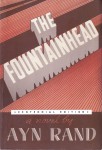The Fountainhead by Ayn Rand (1943. Reprinted by Plume in 2005, Centennial Edition. ISBN978-0-452-28637-5)
If your heroes or heroines of the day include Sarah Palin, Michelle Bachman, Ron Paul, Rand Paul, Clarence Thomas, Alan Greenspan and their ilk (folks who hold individualism to be the most critical of all human attributes and decry altruism and any sense of community obligation amongst men) then this is the book for you. The Fountainhead (along with Rand’s later novel, Atlas Shrugged) lay out, in fictional form, Rand’s radical anticommunist fervor known as Objectivism. Rand’s philosophy, one based upon reason through acquired knowledge and rational egoism at the expense of faith, religion, and ethical altruism, has been the subject of much debate by its supporters and detractors since We the Living, her first novel regarding the struggles between the individual and the state (based upon her own experiences in Communist Russia) was published in 1936. But it was the publication and success of The Fountainhead by Bobbs Merrill in 1943 in America which led many to take up Objectivism, in the face of the advance of Stalinist expansion, and Atlas Shrugged at the height of the Cold War (1957) which increased serious discussion of Rand’s dystopian view of the future if communism is allowed to prevail and capitalism is allowed to fail. You can learn more about the history of Rand and her philosophy at http://en.wikipedia.org/wiki/Ayn_Rand.
What then of Ayn Rand as a fiction author? I previously read (but did not review) Atlas Shrugged. The story of John Galt, a radically independent engineer and Dagny Taggart, owner of a railroad, and their quest to bring America back from the folly of governmental control and collectivism to a place of rugged individualism and reason is not dissimilar from the plot line of The Fountainhead. In both, though Rand seems to want to allow her female protagonists (Taggart in Atlas, Dominique Francon in Fountainhead) to be modern, independent, free thinking and free loving girls, in the end, both disappoint. In reality, the female leads in both stories seem little more than window dressing: Extremely attractive, bright foils for the leading men, (Galt in Atlas and architect Howard Roark in Fountainhead) to couple with and convert to their way of viewing the world. Which is, of course, essentially Rand’s way of looking at the world. And then there are the male characters: The hero (Roark) and the villains (art and architectural critic Ellsworth Toohey being the leader of a “gang” of powerful men and women out to bring America into the communist fold and to destroy men like Roark). As in Atlas, the bad guys are complex to a degree but still, in the end, fairly outlandish in their badness. And Roark? Incorruptible in his beliefs, particularly in his belief of his self worth, Roark stands alone, as the strong, virile superman against the evils of collectivism: ordinariness and sloth. While the dialogue between good and evil is anything but simple to follow, given Rand’s desire to educate her readers about her personal philosophy and its counterpart, the verbal interplay between characters tends to be speechified and long winded whenever there’s a point for Objectivism to be made.
Beyond the characterization and dialogue, there’s of course, plot. Rand juxtaposes the worlds of newspaper publishing and architecture in ways that I’m sure, no one else has ever done. Think Citizen Kane meets Frank Lloyd Wright and you’ll have a snapshot of what Rand brings to the table in the over 700 pages of The Fountainhead. She creates a world where art and architecture are lauded and magnified far beyond their place in contemporary society, where newspapers have more power than politicians or the monied. It’s, as the author of the Wikipedia article on Rand says, a “dystopian” view of the world, of what might be, should collectivism replace individual ego as the basis for human interaction and progress. Slow moving at times due to Ms. Rand’s incredible need to drive home her philosophical point through verbose speeches by the main characters (though nowhere in this book is there a speech approaching that of John Galt’s in Atlas), the plot has its moments.
One particularly memorable scene occurs when Gail Wynand, a newspaper mogul with his eye on Dominique (who is inconveniently married to the story’s whipping boy, Peter Keating, a second-rate architect) interacts with the beautiful newspaper woman’s hapless husband. In a storyline repeated nearly verbatim in the Demi Moore/Robert Redford flick Indecent Proposal (with actor Woody Harrelson in the role of the husband), Wynand offers Keating the lead design role on a massive project Wynand is financing on the condition that Keating not only allow him to sleep with Dominique (who doesn’t veto the idea) but marry her as well. The Keating character is played out in fine fashion throughout this sequence. Would that the rest of the book was as well paced and thought out.
The descriptions of Depression era New York City are wondrously wrought. There’s no question Rand had some talent as a fiction writer. But her talent gets lost in the verbage. Beloved American short story writer, Flannery O’Connor once wrote of Rand’s fiction:
I hope you don’t have friends who recommend Ayn Rand to you. The fiction of Ayn Rand is as low as you can get re: fiction. I hope you picked it up off the floor of the subway and threw it in the nearest garbage pail. She makes Mickey Spillane look like Dostoevsky.
This fiction author has to agree: A worthy read if you’re out to try and understand Ron and Rand Paul and their politics, but not a book to be entertained by. And consider this with respect to the author’s message: There’s a reason that after the recent Wall Street meltdown, Alan Greenspan (an Ayn Rand devotee) announced that he had it wrong; that perhaps the government does have a role to play in the lives of people; even rich people, and the markets.
If you’re looking for well written, compelling works of fiction that transcend an agenda, Ayn Rand is not the author to read.
3 and 1/2 stars out of 5.



